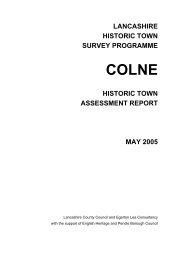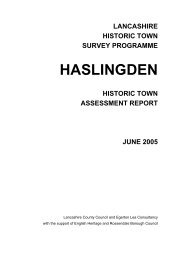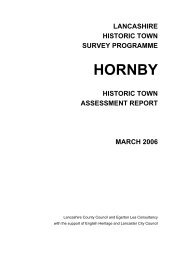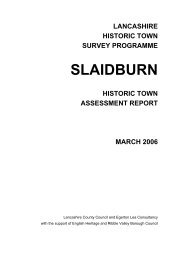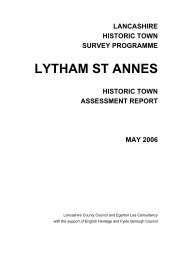ACCRINGTON - Lancashire County Council
ACCRINGTON - Lancashire County Council
ACCRINGTON - Lancashire County Council
You also want an ePaper? Increase the reach of your titles
YUMPU automatically turns print PDFs into web optimized ePapers that Google loves.
<strong>Lancashire</strong> Historic Town Survey<br />
Accrington<br />
Standardised terraced housing and the gridiron layout of the streets gave Accrington a<br />
formal regularity, in agreement with classical precepts of urban design (Miller 1999). The<br />
new urban fabric was regarded as tidy, sober and prosperous by some, monotonous and<br />
ugly by others.<br />
The town’s population peaked in 1911, though physical expansion continued throughout<br />
the twentieth century. Sadly, many of the historic structures and features of Accrington<br />
have been removed during twentieth-century redevelopment. Some were demolished in<br />
‘slum’ clearance schemes before the Second World War following the 1931 Accrington<br />
Improvement Act. Others have disappeared more recently as part of clearances such as<br />
that undertaken in Oak Street, or as a consequence of developments such as the Arndale<br />
Centre or the Broadway inner relief road.<br />
Commercial development<br />
In the earlier nineteenth century, shops were concentrated around the Church Street area<br />
and along Abbey Road. By the 1830s, Warner Street was also developing as a shopping<br />
area (Crossley and Ainsworth 1995). There<br />
was little diversity or specialisation, with<br />
clothing, footwear and basic foodstuffs being<br />
the main goods on offer (Rogerson 1818).<br />
Directories indicate that in the mid-nineteenth<br />
century the major shopping streets were<br />
Abbey Street, Blackburn Street, Blackburn<br />
Road, Oak Street and Warner Street (Slater<br />
1851, Mannex 1855). Burnley Road appears<br />
to have become an important shopping street<br />
by 1878 (Barrett & Co 1878, 267-308), and<br />
Plate 7: Houses along Warner Street,<br />
purpose-built with ground floor shops; 1820s<br />
Stanley Street also seems to have been<br />
significant by the end of the century (Barrett<br />
& Co 1900, 568-591).<br />
In the later nineteenth century shops appear<br />
to have been more widespread and far more diverse than previously. A little evidence of<br />
specialisation occurs in some streets, with Blackburn Road in particular appearing to have<br />
developed as a centre of clothing manufacture and retailing (Barrett & Co 1900). The most<br />
obvious change between 1878 and 1900, however, was the appearance and proliferation<br />
of the fish and chip shop, for 57 individuals were listed as fried fish dealers in 1900 (Barrett<br />
& Co 1900, 581). How many of the shops in the early nineteenth century were purposebuilt<br />
is difficult to estimate, but certainly in the later nineteenth century Accrington’s shops<br />
were generally purpose-built (LRO MBAC cc 8099/1). Most were built as single shops<br />
within the ground floors of otherwise domestic buildings, but larger commercial<br />
developments also took place.<br />
Opposite the Peel Institute a purpose-built terrace of shops known as Piccadilly was built<br />
(Singleton 1928, 70; AGWC Plan 2). In existence by 1851 (Slater 1851, 11-15), this was<br />
demolished in the twentieth century. The largest purpose-built shops were those belonging<br />
to the Co-operative society, the first of which opened in 1860. The Accrington Co-op<br />
became the largest society in <strong>Lancashire</strong> (Haslam 1910, 79). As well as numerous smaller<br />
society shops it had four three-storey stores, all on corner sites and in key commercial<br />
locations (Atkinson 1972, 133) – two were on Abbey Street, one on Oak Street (now<br />
demolished) and one on Brown Street (LRO MBAC acc 8099/1).<br />
The Market Hall was built in 1868 at a cost of £28,300, to a design by John Doyle of<br />
Liverpool. It was purposely designed in a classical style to complement the neighbouring<br />
Peel Institute, and was described in a local paper as a ‘living treasure of art’ (Winstanley<br />
2000, 158). It had rest rooms, refreshment areas and fifty-two permanent stalls (Atkinson<br />
1972, 110). In 1894 the Post Office Arcade was built, partly to provide an adequate post<br />
© <strong>Lancashire</strong> <strong>County</strong> <strong>Council</strong> 2005 28



